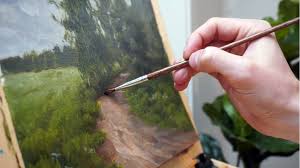A Look Into the World of Minimalist Mastery: An Exploration of Ink Painting for Novices
Ink painting, or “sumi-e” as it is known in Japan, is an elegant and expressive art form that dates back centuries 酒精墨水畫. This ancient practice, rooted in Eastern traditions, is a testament to the beauty found in simplicity and minimalism. For those new to ink painting, embarking on this artistic journey can be both exciting and deeply rewarding. Here’s a glimpse into the basics of ink painting to help beginners get started.

Understanding the Basics
Ink painting is typically performed using black ink, although colored inks can also be used. The primary aim is to capture the essence or spirit of the subject rather than its direct appearance. This art form emphasizes fluidity, control, and spontaneity, often depicting subjects from nature, such as bamboo, plum blossoms, landscape, and animals.
Essential Tools
To begin your ink painting journey, you’ll need a few fundamental tools:
1. **Ink Stick & Ink Stone**: Traditionally, the ink is made by grinding an ink stick on an ink stone with water to produce varying shades of black.
2. **Brushes**: Ink painting requires special brushes made from various materials, including animal hair. These brushes are flexible, allowing for both broad and delicate strokes.
3. **Paper**: The best paper for ink painting is absorbent, such as rice paper or “xuan” paper, which allows for smooth ink flow and a beautiful absorption effect.
4. **Brush Rest & Water Droppers**: Additional tools like brush rests keep your workspace tidy, and water droppers help control the amount of water mixed with the ink.
Basic Techniques and Practices
1. **Holding the Brush**: Unlike Western painting techniques, sumi-e artists hold the brush vertically. This grip allows greater control over the weight and direction of the stroke.
2. **Control and Fluidity**: One of the key lessons in ink painting is learning to control the brush to create both thick and thin lines, dark and light shades—often within a single stroke. It’s about mastering the balance between intentional strokes and the natural flow of the ink.
3. **Practice Leaves and Flowers**: A common practice for beginners is to start with simple subjects like leaves or flowers. This helps to develop muscle memory and an understanding of how the brush and ink work together.
4. **Embrace Mistakes**: Ink painting values spontaneity and the beauty of imperfection. Each stroke is unique and cannot be undone, which teaches practitioners to embrace their mistakes and see beauty in the unexpected.
Mindfulness and Philosophy
Ink painting is as much a meditative practice as it is an artistic one. It encourages mindfulness and presence, as artists must be entirely focused on their brushwork and breath. Each painting session becomes an opportunity to cultivate patience, discipline, and an appreciation for simplicity.
Final Thoughts
Starting with ink painting can be a humbling and enlightening experience. For beginners, it’s important to approach the practice with an open mind and a willingness to learn and experiment. The journey of mastering ink painting is continuous, with each brushstroke bringing a deeper understanding of this timeless art. Whether it’s the calm flow of ink or the serene composition of subjects, ink painting opens a path to a deeper connection with art and oneself. So gather your tools, find a quiet space, and let the ink guide you on this beautiful artistic adventure.
